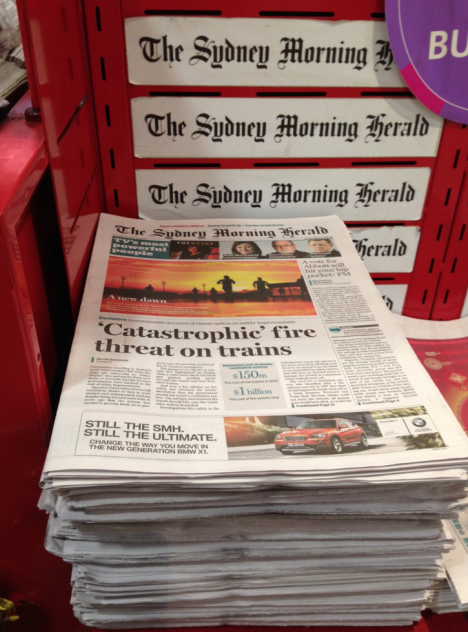The end of an era for Fairfax: but does size matter?
 In this post for The Conversation, the University of Melbourne’s Andrea Carson explores the differences in perception between broadsheet and compact.
In this post for The Conversation, the University of Melbourne’s Andrea Carson explores the differences in perception between broadsheet and compact.
After 159 and 172 years respectively, the broadsheet tradition has ended for the weekday editions of The Age and Sydney Morning Herald (SMH). Today, both these Fairfax Media mastheads became tabloid-sized newspapers for the first time. The question is: does size matter in terms of editorial content? Will we, as readers, see a change in the content and selection of stories in these smaller Fairfax newspapers?
According to Fairfax CEO Greg Hywood, the answer is no. He has emphatically argued when explaining the rationale for the size switch (to save costs through the closure of the Tullamarine and Chullora printing plants) that the “compact” versions will contain the same “quality journalism” as when they were broadsheets.



Today’s SMH just looks like a slightly reworked (and slightly better) Sun Herald. The problem is they are stuck between two worlds – still with the broadsheet pretence but in a tabloid format. I expect the Fairfax bosses will take a long, long time to admit it’s “tabloid” and will carry on with the B.S “compact” notion, which isn’t fooling anyone. In a world of journalism where euphemisms are frowned upon, compact is the dumbest of them all.
Fairfax’s own Newcastle Herald went “compact” a long time ago, and it’s only just now realising that it is in fact a tabloid. If the SMH takes that long to adjust, it won’t survive.
Size may not matter but in the following article:
http://www.smh.com.au/nsw/leth.....2ffep.html
had a photo with the following caption “Greg Wood … decieded to try heroine.”
I’m going to assume it is bring your child to work day…
Interesting research and no doubt merit to it. Two observations. As a reader of The Times in the UK, the product post compact change was more appealing to read, both the content and physically (tube and train nightmare with broadsheet). What felt like a paper for my parents before the change began to feel like a paper for me post downsize.
However, paper change is a moot point, all media now compete for the mobility empowered reader, so this is not a game changer but a sensible way for newspaper media to position their brands to younger, digitally driven demos and this means shaping the content and critically the brand accordingly. No baby out with the bath water though.
Like comparing the woolly mammoth with the sabre-tooth tiger.
The “Resized” Papers will look more at home along side their free counterparts. Much easier to light BBQ’s with.
I am assuming the research that Andrea has done was purely of the desk variety.
Having undertaken and evaluated a number of titles shift in format in a professional capacity it is difficult to look at the impact of the change from broadsheet to tabloid on a titles content without considering the wider context. By that I mean the change in the type of content carried by newspapers since moving from broadsheet to tabloid has not only been driven by the change in format but the fact that growing numbers of readers access news on the internet or other sources than newspapers.
Newspapers are no longer about breaking news. It is rare that people will first encounter a major news story (investigative news stories aside) in the print version of their daily newspaper. They are no longer first with news. Their role has become a vehicle for allowing readers to understand and evaluate news stories. Readers can read informed writers views/opinions on a story and get a deeper level of understanding about participants in the story. This is what has shaped the changing content of newspapers over recent years particularly for the broadsheets migrating down in size.
Tabloids on the other hand having progressively moved content away from breaking news further into gossip, celebrity and sport. News stories are given a salacious spin usually with a participant in the story paid to deliver an exclusive inside scoop. Tabloids are actively migrating into the content space previously owned by the weekly magazines. Again these magazines (due to their publication frequency) could never break a story (newspapers filled that roll) but would often look for the story within the story particularly where a celebrity was involved.
Apologies for the stream of consciousness that just flowed out. I have always had an interest in the effect on content in traditional media that the internet has had.
Was at a coffee shop yesterday and people were not picking it up. They must not have recognised what it was.
True up to a point, Researcher, but the Herald Sun’s editor might disagree given its front pages in the last two days.
The most important person in the news right now is the irrepressible Mr Source who is very good with a tape recorder and telephone lines.
I just checked out the Daily Life section and there are six writers featured – all of them women! They are writing on topics such as “women for Julia” and “Australia’s richest women” and “why women should stop apologising.”
If some women think the title “female perspective” if offensive, maybe they should start lobbying to change reality instead of just the label – boot half of those women out and source some opinions from men! Publish something about why men should stop apologising so much or “men for Tony”. Then they could call it “balanced perspective”.
But somehow I don’t think that’s what they really want.
This recent attention on format is all a dead cat bounce.